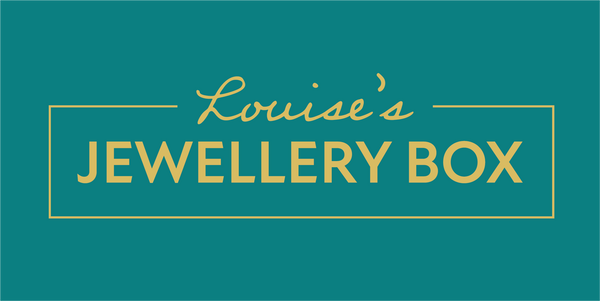There are many different jewellery finishes, especially in fashion jewellery and looking at a jewellery website can feel somewhat confusing. What does silver mean? Is plating long lasting? Can I get my jewellery wet?
In this blog I hope to demystify some of the misconceptions about different types and the pluses and minuses of each one that you will find in Louise's Jewellery Box
GOLD PLATED
The gold pieces found in Louise's Jewellery Box are made of a base jewellery metal and then electroplated with a layer of real gold. The technique involves placing the jewellery piece into a solution containing the gold and then running an electrical current through it.
The carat of the gold will be determined by the style, shape and supplier of the item of jewellery.
The main advantage of plated jewellery is to make statement jewellery an accessible price for most people. By purchasing plated gold jewellery for a fraction of the price of solid gold, fashion looks can be created and updated each season. Many pieces are also based on an original designer look just as clothes are in the fashion industry
The main disadvantage of plating over solid gold is that the plating will wear off over time. To prolong the life of your new jewellery remember the 5 S's.
Avoid sprays (perfume, hairspray etc). Avoid sweat as skin chemicals can eat into the plating. Never swim while wearing your jewellery. Never shower or bathe wearing your fashion pieces and never sleep in it. Think last on first off!
RHODIUM PLATED
To achieve a silver finish, many fashion items of jewellery are rhodium electroplated in the same way that gold pieces can be. Much of our collection is Rhodium and I'm sure you are probably wondering why.
Rhodium, while a silver colour, is actually part of the platinum family. It's high purity rating means it is more durable and resistant to tarnish, wear and tear. In fact many high end pieces of jewellery, including white gold wedding rings, are plated with rhodium.
As with gold plating, Rhodium makes statement and up to date fashion items more accessible. A big advantage is that Rhodium is naturally hypoallergenic making it suitable for everyone.
The disadvantage though is that, as with gold plating, it needs care to prolong it's life so avoiding the 5 S's is still a must.
STAINLESS STEEL
Stainless steel jewellery is popular among both men and women for several reasons
-
Affordability and Durability: Stainless steel is affordable and durable, making it a practical choice for everyday wear. Unlike softer metals, it's scratch resistant and can withstand most daily activities with no damage
-
Tarnish Resistance: Stainless steel jewellery doesn’t tarnish, so it maintains its appearance over time with minimal maintenance.
-
Hypoallergenic: It’s unlikely to cause allergic reactions, making it suitable for those with sensitive skin.
-
Recyclable and Environmentally Friendly: Stainless steel is infinitely recyclable, contributing to sustainability
Disadvantages - Stainless Steel isn't suitable for all jewellery designs so options may be more limited.
On the whole stainless steel is good value and an excellent choice if you want an item of jewellery that is more durable and withstanding of everyday wear and tear.
WATERPROOF JEWELLERY
The waterproof Jewellery in Louise's Jewellery Box is made from a base of 316L Stainless Steel
316L Stainless Steel is a premium grade of stainless steel known for its durability, corrosion resistance, and hypoallergenic properties. This metal is particularly favoured for jewellery due to its ability to withstand daily wear without tarnishing or rusting. Its strength ensures that pieces remain intact and maintain their appearance over time.
Titanium is then used to adhere to the stainless steel and finally the gold plating using a process called PVD
Why PVD plating? PVD, or Physical Vapor Deposition, is a technique that involves vaporizing a solid material in a high-vacuum environment and depositing it onto the jewellery. This creates a hard, wear-resistant layer that enhances the jewellery's durability and resistance to tarnish while providing a visually appealing, uniform finish. PVD coatings are hypoallergenic, making them ideal for those with sensitive skin. They offer superior hardness and scratch resistance compared to traditional plating methods, which can wear off quickly.
Our Waterproof Jewellery supplier offers a 180 day guarantee against breakages and tarnishing. While this plating won't last forever, it does offer a a more durable and hardy alternative.
The only disadvantage I can see is that the PVD plating gives a more antique style of gold. If you only like bright and shiny then this is maybe not the option for you .
STERLING SILVER
Sterling silver consists of 92.5% silver and 7.5% other metals. The most common alloying metal is copper, but nickel or zinc can also be used.
Unlike pure silver (which is too soft for practical use), sterling silver is more durable and suitable for everyday wear. The added metals enhance its strength and resistance to bending or scratching. Authentic sterling silver pieces are usually stamped with a hallmark that indicates its purity. Look for the “925” mark, which confirms the silver content.
Sterling silver is particularly suited for delicate jewellery and looks amazing set with coloured stones or crystals. It is also a favourite when choosing items for children. A gift made of silver is always a treat to give and receive and silver is to this day many peoples first choice for jewellery
Disadvantages -
Sterling silver can tarnish over time due to exposure to air and moisture. Regular cleaning and proper storage help maintain its lustre. It can also be easily scratched and it tends to bend out of shape after a long period of time so treat with care.
